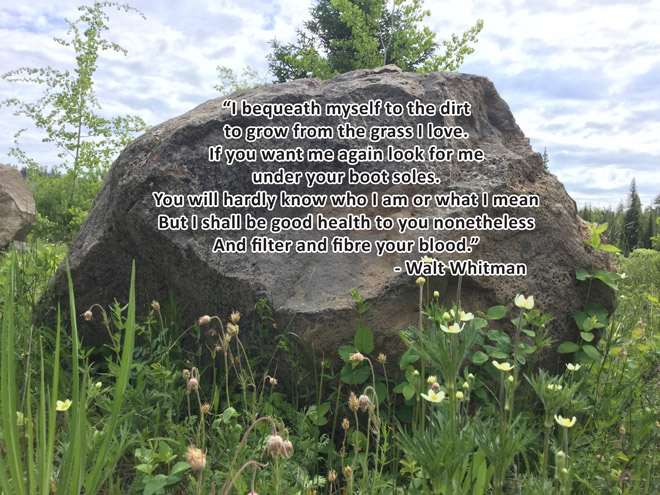By Nicola Finch –
Do you want to be buried or cremated?

In our death phobic society, that’s one of the more acceptable questions when broaching death as a topic of conversation. Frankly, I think we need more and simpler choices—burial options that cause no harm to people or the environment. We understand the necessity to quit using plastic bags and drinking straws; surely, it’s time to stop polluting the planet with our final farewell.
To be kind to those we leave behind, it behooves us to decide what we want done with our bodies once we’re dead. You might say “It doesn’t matter,” or “They can do whatever they like with me,” but if you have not made your wishes known, someone who loves you will have to make those decisions in the hours after your death. And it will matter to them. They will want to do right by you. The dying time of a loved one is challenging when everything is in place. When death is unexpected, and no one knows what we wanted, we make it unnecessarily hard on grieving family and friends.
In British Columbia, we currently have two legal choices for the disposition of our bodies: cremation or burial.
Cremation is the number one choice for more than 80 per cent of British Columbians, the highest percentage of any province or state in North America. There are many reasons why we are choosing cremation; some of them personal, some financial, and some societal. Cremation, while it has adverse effects on the environment (the release of mercury into the air and the use of fossil fuels), is decidedly more eco-friendly than traditional in-ground burial. Direct cremation is also considerably less expensive than traditional burial. In BC, costs can range from about $1,000 for direct cremation to $25,000 for a burial lot in Vancouver. Our rural cemeteries are not nearly so expensive, but they tell the same sad story underground.
Traditional cemeteries: those tidy rows of markers and headstones on manicured lawns are often beautiful havens for birds and wildlife in otherwise built-up urban areas. Families find comfort there, and graveyards are endlessly fascinating for tadophiles and genealogists like me. Unfortunately, for the last few hundred years we’ve been filling these cemeteries with concrete and fiberglass and toxic embalming fluids, as well as a forest of hardwood caskets. We are running out of space in our cemeteries. We’ve outgrown them in more ways than one.
Green burial, thankfully, is making a comeback. Green burial returns our bodies gently to the Earth allowing natural decomposition and benefitting the environment. Since chemicals are not permitted, there is no embalming. Your loved one could be wrapped in a shroud, or placed in a biodegradable casket, which can be as simple as a sturdy cardboard receptacle (decorated by family and friends) or made of natural and sustainable materials such as wicker or local bug-killed pine.
The Green Burial Council of North America specifies three types of Green cemeteries: hybrid burial grounds, natural burial grounds, and conservation burial grounds.
Again, BC is way ahead of the game. The Denman Island Natural Burial Cemetery, which opened in the fall of 2015, is the first contemporary all-natural conservation burial ground in Canada. The Woodlands at Royal Oak Burial Park in Victoria, which opened in 2008, was Canada’s first urban Green burial park.
Municipal cemeteries in BC, as they upgrade or expand, are getting on board with hybrid Green burial sections, and while not ideal, it’s a start. Personally, it means if I die this year I could request a Green burial in the cemetery in my old hometown instead of opting for cremation. I like the idea of being buried close to the bones of my ancestors.
Len Robson, public works manager at the City of Penticton, confirmed they have included a Green burial section in their most recent expansion of Lakeview Cemetery. Robson says they hope to have all the bylaw changes in place and have it open to the public early this year.
The Village of Cache Creek’s website states that its municipal cemetery includes an environmentally conscious Green burial section. A simpler version of Green burial is also available at the Powell River Regional Cemetery.
Although it may be 10 years away, the Williams Lake area should expect to see Green burials available when the city opens its new cemetery. If the demand is there, (that means we have to ask!) perhaps it will happen sooner.
I’m committed to advocating for natural burial grounds and Greener funeral practices throughout BC as well as natural woodland places of remembrance for cremated remains. I see great potential in rural BC for the development of Green woodland burial grounds in every community.
Natural burial allows us to die as we lived, with as light a footprint as possible. See more at: www.greenburialbc.ca, www.greenburialcouncil.org, and www.greenburialcanada.ca.
Nicola Finch lives off-grid in a remote area west of Williams Lake. She and her husband are co-owners of Touch Wood Rings. They offer custom handcrafted wooden rings including wooden memorial rings inlaid with the ashes of a loved one. Nicola’s passion is holistic end-of-life care, from death doulas to Green burials. Learn more about their Cariboo Community Deathcaring group. Contact [email protected] or find her on Facebook @greenburialbc @touchwoodrings @memorialrings.
